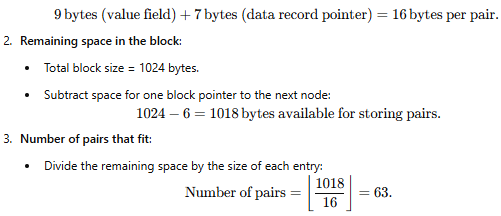Correct option is A
The
order of a leaf node in a B+ tree refers to the maximum number of (value, data record pointer) pairs it can hold. Given the block size and the size of different fields, we calculate this as follows:
Data Given:
1.
Block size: 1 KB = 1024 bytes
2.
Value field size: 9 bytes
3.
Data record pointer size: 7 bytes
4.
Block pointer size: 6 bytes (used to point to the next leaf node for linked list structure).
Calculation:
1.
Space per entry: Each (value, data record pointer) pair takes:

Information Booster
1.
B+ Tree Overview:
· A B+ tree is a self-balancing tree data structure used for databases and file systems.
· Leaf nodes store (key, value) pairs or (key, pointer) pairs.
2.
Order of B+ Tree:
· The order is determined by the size of keys, pointers, and the block size.
· Ensuring efficient disk access is crucial in choosing the block size.
3.
Space Efficiency: In databases, larger blocks and smaller keys allow more entries in each node, reducing the height of the tree.
Additional Knowledge
· A leaf node must also store a pointer to the next leaf for sequential access.
· As the block size increases, the height of the B+ tree decreases, improving search time.
· Non-leaf nodes in a B+ tree store only keys and block pointers, not data pointers.






 English
English 50 Questions
50 Questions 60 Mins
60 Mins